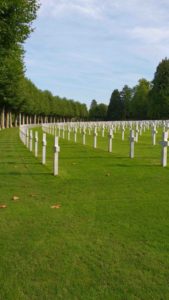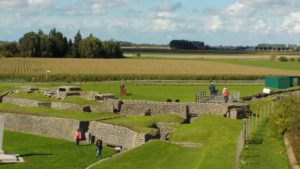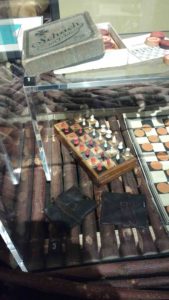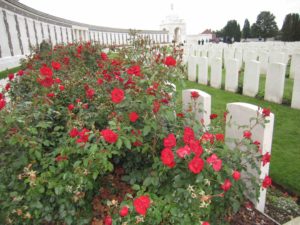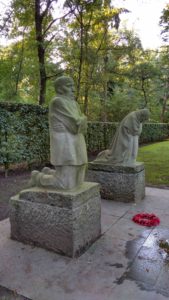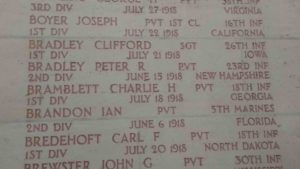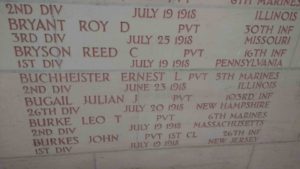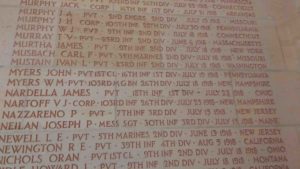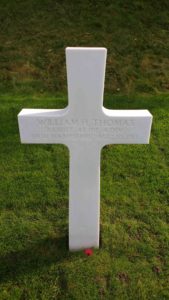Travel, World War I »
All Not Yet Quiet on the Western Front
November 11, 2018 | Comments Off on All Not Yet Quiet on the Western Front | Betsy Woodman
Report from the Western Front
Lunch is delicious: venison in a root vegetable sauce, rosettes of garlicky whipped potato, fruit sorbet topped with a swirl of chocolate. The wine flows, as do the Belgian beers. The point of this river cruise, however, is not a gastronomic extravaganza, but a commemorative tour of the Western Front, the main theater of war during World War I.
In the next few days, we’ll see cemeteries—lots of cemeteries—and spectacular memorial structures. Towers reaching for the sky, triumphant arches, stunning statuary—and vast walls with the names of the missing.
We’ll wander through trenches and dugouts, descend 65 feet down into a limestone quarry, visit forts and bunkers and medical dressing stations.
And we’ll go to museums chock full of World War I material culture: tanks, uniforms, rifles, bayonets, grenades…. Plus, personal items that soldiers carried to preserve a shred of sanity—musical instruments, chess sets, pipes, diaries, and photos of sweethearts.
Why would you want to visit places that are associated with war? This kind of travel is sometimes called “dark tourism,” or even thanatotourism–tourism having to do with death. What kind of a morbid person would tour battlegrounds?
Turns out that a lot of people tour battlegrounds, and always have. In the nineteenth century, British tourists flocked to Waterloo to see where Napoleon had been defeated. In America, Revolutionary War and Civil War battle sites continue to draw lots of visitors.
World War I—the Great War—1914 to 1918—was supposed to be the war to end all wars, the war to make the world safe for democracy. It did neither. Instead, it created orphans and widows and grieving parents and fiancées and friends.
70 million military personnel served. Close to 10 million were killed. Another 21 million were wounded and went through life on crutches or peg legs. Some had faces so mutilated that they wore masks or hid from the world; others were mentally crippled from shell shock. Perhaps 7 million civilians perished, and countless people were driven from their homes or starved to death.
On one side were the Central Powers, Germany and the Austro-Hungarian Empire, and on the other, the Allied Powers—France, the UK, and Russia. Many more nations joined in. The United States entered on the the Allied side in 1917.
Troops clashed in the Middle East, in Africa, and in Eastern Europe, but the major location of the fighting was the Western Front—a strip of territory 460 miles long, stretching from the North Sea across Belgium and Northern France to the Swiss border.
Historic battles took place around the Belgian town of Ypres. In France, the 120-day-long battle at the Somme and the 300-day battle at Verdun became the very definition of hell.
We visited Ypres, and the Somme, and Verdun, along with Vimy Ridge (sacred to Canadians), Belleau Wood (sacred to the US Marine Corps) and many other places.
We were not the first visitors to these sites.
Even during the war, visitors and journalists wanted to get a first-hand view of the front. Soldiers didn’t like these interlopers much—they called them “trench tourists.” A satiric poem called “High Wood” by British Lieutenant John Stanley Purvis envisioned the curious hordes that would invade the area after the war:
Madame, please,
You are requested kindly not to touch
Or take away the Company’s property
As souvenirs; you’ll find we have on sale
A large variety, all guaranteed.
In my grandfather’s World War I memorabilia, I found a little yellowed flyer announcing
VISITS TO THE BATTLE-FIELDS.
Bookings are now being made. Short Tours from Paris, designed to visit all the principal battlefields in France and Belgium, as well as Complete Comprehensive Tours, under guidance of fully-informed first-class English-speaking chauffeurs, are being arranged as and when Authorities open up access to War Zone.
Leave name and address, if interested…
In 1919, the floodgates were opened, and 60,000 people visited the Western Front. In the next two years, more than thirty guidebooks to the area were published in English alone. Veterans and soldiers still in uniform returned to places they had fought or lost their comrades.
Family members came looking for their loved ones’ graves. As the British did not ship bodies home, British travelers were numerous. Americans would eventually repatriate bodies, but many fallen Americans also remained in Europe. The U.S. government paid for bereaved wives and mothers to travel on Gold Star Mothers Tours to visit their husbands’ or their sons’ graves. (Apparently, fathers didn’t get the same privilege.)
In those early days, visiting the front was dangerous travel. It was expensive and you had to have a special pass. Unexploded bombs would suddenly go off and bands of deserters roamed about preying on travelers. The novel, A Century of November,by W. D. Wetherell, captures the atmosphere of a gray, muddy landscape reeking of poison gas and riddled with barbed wire.
A 1919 Michelin Guide provided travel directions such as:
“Pass through Chapelle d’Armentières (completely destroyed).”
“Go through Houthem… razed to the ground.”
Photos show knots of people standing in front of rubble, with an occasional bit of tower where a cathedral had been.
On our tour, there was a huge amount of information to absorb, and I’m still processing the messages of the Western Front.
First, some thoughts on the cemeteries, the cities of the dead.
The cemeteries of the Western Front are visually stunning—pristine, well tended, with beautiful plantings. But they tell a brutal truth—the sheer scale of the killing. You see row on row on row of identical white headstones or crosses. And then you go down the road, and see hundreds more.
Tyne Cot Cemetery and Memorial for the Missing is the resting place for 11,900 servicemen from the British Empire. The architect, Sir Herbert Baker, said he wished the cemetery to have “the appearance of a huge, well-ordered English churchyard with its yews and cedars.” So, the grass is cut to a precise length and rose bushes soften and beautify the scene.
How different from the chaos in which these soldiers died. How different from the filth and deafening noise they endured. A hundred years later, the sun shines on the graves, the air is fresh. Death is quiet and clean.
French cemeteries expressed perhaps a more realistic attitude about war. The Douaumont Ossuary at Verdun, a receptacle for bones, contains the femurs and pelvises and the skulls of perhaps 130,000 unidentified German and French soldiers. Their bones are jumbled together in chambers, visible through little windows on the outside.
The French call a spade a spade; they don’t avoid the word “dead.” On their crosses, beneath the soldier’s name, is the inscription, “Mort Pour La France.” I walked down a row and took note of a few. Joseph Ferriot, Mort Pour la France. He died 21stof May, 1918. Marcel Paindessous, Mort Pour la France, on the same day. Charles Bord, Mort Pour la France, also dead on the 21stof May. In life, were they friends? Now they lie together.
All the Western Front cemeteries were sobering, but the German ones were the most powerful reminder of grief. The treaty of Versailles forbade the German graves to have white headstones, and the Belgian government would not allow them to have vertical grave markers. Therefore, at the Vladslo German cemetery, where more than 25,000 men are buried, burial sites are marked with low gray stone squares. The names of up to ten soldiers are carved on each. They are typical German given names—Oskar, Heinrich, Erich. Fritz, Ludwig, Johann, Werner. Youngsters, really, now lying in permanent desolation.
Sorrow is palpable in the nearby statues:
A final word on the cemeteries. The eye doesn’t see it today, but the whole area is a burial ground. 300,000 dead combatants were never found, and many are lying just below the surface. When a new building or highway is constructed, the bulldozers turn over fragments of human bone.
Why dwell on the so-called Great War, anyway? World War I is over, right? We humans have processed that catastrophe, and are ready to move on.
But no. World War I isn’t over. All isn’t yet quiet on the Western Front.
It looks tranquil and safe. In the Somme battlefields, sheep graze in lush grassy fields where, on July 1, 1916, the British army lost 19,000 soldiers in a few hours. It’s tempting to conclude that a benevolent Mother Nature has fixed things. But she hasn’t, not really. The grassed-over land is full of strange ripples and bumps and concave places. Mother Nature has made some cosmetic fixes and papered over some evidence. But she hasn’t deep-cleansed the poisoned and booby-trapped earth.
During the war, 700 million artillery and mortar rounds were fired on the Western Front. An estimated 15% of them overall (more in certain battles) failed to detonate. Every year, spring plowing, or even just the natural freezing and thawing of the earth, sets off explosions. Some farmers have to have armored tractors.
Since 1946, 630 French bomb disposal specialists cleaning up the area have died. There will likely be more in the years to come. We don’t yet have the final death toll for World War I.
Woods and meadows are closed off, with signs warning “Undetonated explosives.” By some estimates, the area won’t be cleaned up for another 200 years—if ever.
What is the Western Front trying to tell us? Disasters caused by human beings happen on a scale that defies understanding, and nothing I saw reassured me that an equally terrible or worse disaster won’t happen again. The memorial structures, with their triumphant arches and towers are more about victory than about peace. As long as nationalism is rampant on the planet, and leaders are capricious and thin-skinned, we’re vulnerable. And once a war starts, it’s not over for a long, long time. Its effects last for generations.
In the meantime, visitors to the Western Front try to deal with the enormity of what happened there.
The Last Post Ceremony at the Menin Gate, in Ypres, has been held every night at 8pm since 1928. Buglers play, a wreath is laid, and these lines are recited:
They shall grow not old, as we that are left grow old:
Age shall not weary them, nor the years contemn.
At the going down of the sun and in the morning
We will remember them.
At the Aisne-Marne American Cemetery and Memorial near Belleau Wood, a member of our tour group read a poem in the chapel, and a veteran laid a wreath at the flagpole. The group stood at attention while the Stars and Stripes were lowered and the Star-Spangled Banner was played. A lump rose in my throat.
I searched the chapel wall for the names of New Hampshire boys. I found six, all soldiers whose bodies were never found. Outside, I found the grave of a New Hampshire soldier actually buried there. All died in the summer of 1918.
I knew nothing about them then except for their names, the dates of their death, their ranks, and their divisions. Still, there was a connection. They were from my beloved home state.
Now, back at home in New Hampshire, I wonder: while they were alive, would those six young men have taken any comfort in knowing that, a hundred years later, a stranger would say their names out loud?
I don’t know, but in any case will do this small act of remembrance.
In chronological order of their death:
Private William M. Bourdeau, 23rd infantry division, 2nd division, dead on June 6.
Private Peter R. Bradley, 23rd infantry division, 2nd division, dead on June 15.
Private Leslie G. Whiteman, 103rd infantry, 26 thdivision, dead on July 17.
Private W. M. Myers, 103rd machine gun battalion, 26th division, dead on July 18.
Private Julian J. Bugail, 103rd infantry, 26th division, dead on July 20.
Corporal V.J. Nartoff, 103rd infantry, 26th division, dead on July 23.
2nd lieutenant William H. Thomas, 47th infantry, 4th division, dead on August 10.
New Hampshire boys who never made it home. Dead for the United States. They didn’t start the war. But they did help finish it.
Rest in peace.
This is an edited version of a talk I gave to the Kearsarge Unitarian Universalist Fellowship on November 5, 2017. For more photos and thoughts on World War I, please scroll down “Categories” (on the right) and click on “World War I.”

